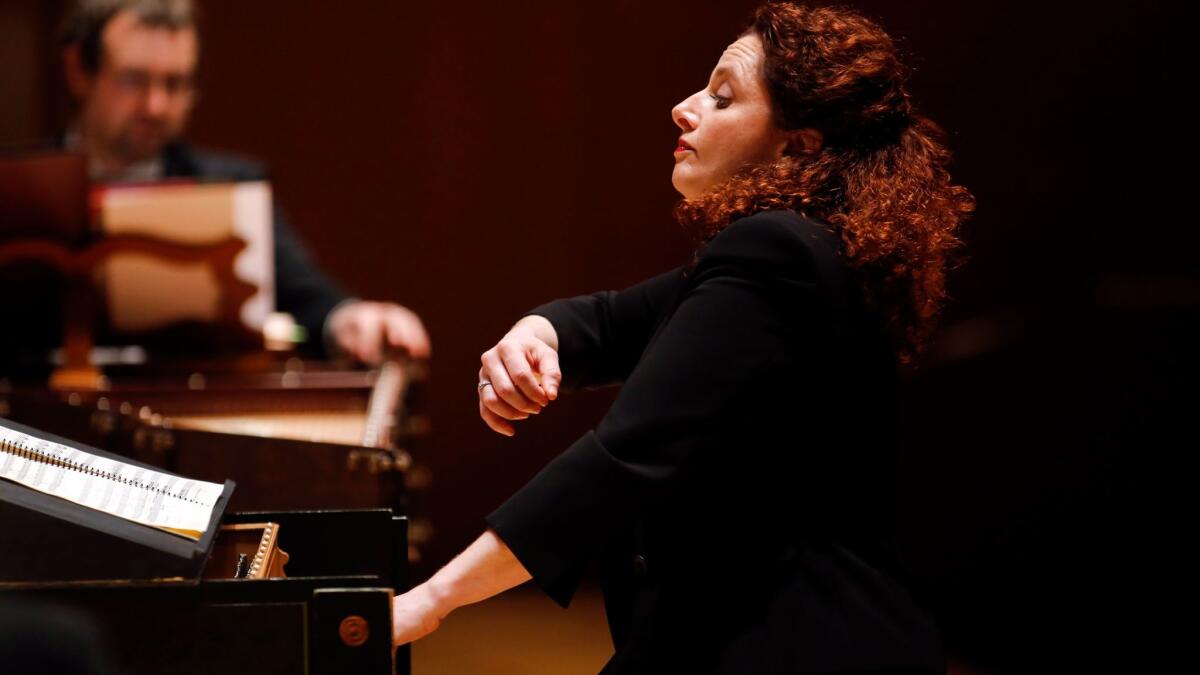Review: The L.A. Phil is modern even when it’s Baroque

- Share via
“The Messiah” and “Christmas Oratorio” may be waiting in the wings, but Handel and Bach are already at hand. The season of the Baroque has begun, and it’s proving that it can be the timeliest of music if we let it.
The Los Angeles Philharmonic, for one, is wrapping its signature 12-hour new-music marathon Noon to Midnight on Saturday in a program conducted by the exhilarating French harpsichordist and early music specialist Emmanuelle Haïm. In that contemporary spirit Thursday night (and repeating Friday and Sunday) at Walt Disney Concert Hall, she made Purcell, Bach and Pergolesi sound newly born.
This comes on the heels of the L.A. Phil having presented last week the outstanding French early music group Les Arts Florissant, led by William Christie, in an urgently idyllic semi-staging of two short Baroque operas. Even this weekend’s classic football rivalry between UCLA and USC is being mirrored in a Handel opera rivalry. Opera UCLA is presenting a multimedia reworking of rarely encountered “Amadigi,” while the USC Thornton opera program is staging Handel’s final operatic masterpiece, “Alcina.”
Haïm might be seen as simply the latest in the L.A. Phil’s string of notable female conductors this fall. She is certainly that. Women are still a rarity in what might seem like an antiquated early music world. She has her own brilliant period instrument ensemble, Le Concert d’Astrée, but made her U.S. orchestra conducting debut with the L.A. Phil six years ago, beginning an ongoing relationship. She also has a connection with Les Arts Florissant, where she began her career as harpsichordist and assistant to Christie.
For the first half of the program Thursday, she led the L.A. Phil from the harpsichord in a colorful performance of a suite from Purcell’s masque, “The Fairy Queen,” and an exuberant one of Bach’s Third Orchestra Suite, with its celebratory trumpets and startling drums and its famous air (that a 19th century violinist turned into “Air on the G String”).
Period instruments were infiltrated into the modern ensemble (recorder, lute especially and Baroque percussion). Tempos were sprightly as we suppose they were in olden times. The violins toned down the vibrato. She clearly knew what she was doing as a HIPster (HIP being the fashionable acronym for historically informed performance).
And she just as clearly didn’t care. Haïm’s great contribution to Baroque music is to go beyond the scholarly (boys) school and conduct her way. She is personal. She is physical. She waves her arms and moves her body as if coaxing emotion out of restrained players. She doesn’t so much conduct an orchestra as partner with individuals, one on one. She makes it seem as though she directly addresses each ensemble player as an individual.
The revelation was Pergolesi’s “Stabat Mater,” the composer’s sequence of a dozen demonstrative outbursts from Mary watching her son on the cross. Written as the composer himself lay dying in 1736, at the age of 26, in a Naples, Italy, hospital (you can only imagine), Pergolesi is a self-effacing patient in his music. He tries his best not to make those around him worry. He looks death in the face with a ready, unrealistic smile. The “Stabat Mater” is a Baroque hit because it is so gosh-darn gorgeous, with its beautifully entwined soprano and alto soloists and soothing strings.
Haïm, however, has little use for artificial sentiment. Without her harpsichord, she conducted the “Stabat Mater” like a dancer (which was her early training). Her arms opened wide to cradle the orchestra. She gave permission to let it all out.
The soloists, the powerful Laura Claycomb and the even more powerful countertenor Christophe Dumaux, offered arresting assessments of suffering, from Claycomb’s wails (something I’ve never heard before in this score) to Dumaux’s outbursts of anger. Rhythms crackled, and in the process, the performance became a kind of hospital drama, a call for inner strength. Death something not be taken lying down, the “Stabat Mater” suddenly sounded like a call to action.
It was also very, very beautiful, far more beautiful than a typically sweet “Stabat Mater.” Instead, this was, HIP or not, a strikingly modern performance, bringing out all the inventive characteristics of that composer that so attracted Stravinsky that he made his own Pergolesi suite, “Pulcinella.”
That connection was particularly apparent to me Thursday, having earlier in the day happened to hear a broadcast on the internet from the Helsinki Festival of another female conductor, Yuja Wang, leading “Pulcinella” with the Mahler Chamber Orchestra. Yes, that Yuja Wang!
The pianist, who is quietly beginning to try her hand at conducting, eliminated the exaggerated froufrou that has come to encumber arrangements, closely following the lead of Stravinsky’s own performances or, maybe, Pierre Boulez, or, maybe even Haïm. I began to wonder Thursday night that had Stravinsky heard Haïm’s Pergolesi he would not have even needed to bother with “Pulcinella.”
♦ ♦ ♦ ♦ ♦ ♦ ♦ ♦ ♦ ♦
L.A. Phil with Emmanuelle Haïm
Where: Walt Disney Concert Hall, 111 S. Grand Ave., L.A.
When: 8 p.m. Friday, 2 p.m. Sunday
Tickets: $20-$194
Information: (213) 850-2000, www.laphil.com
More to Read
The biggest entertainment stories
Get our big stories about Hollywood, film, television, music, arts, culture and more right in your inbox as soon as they publish.
You may occasionally receive promotional content from the Los Angeles Times.










